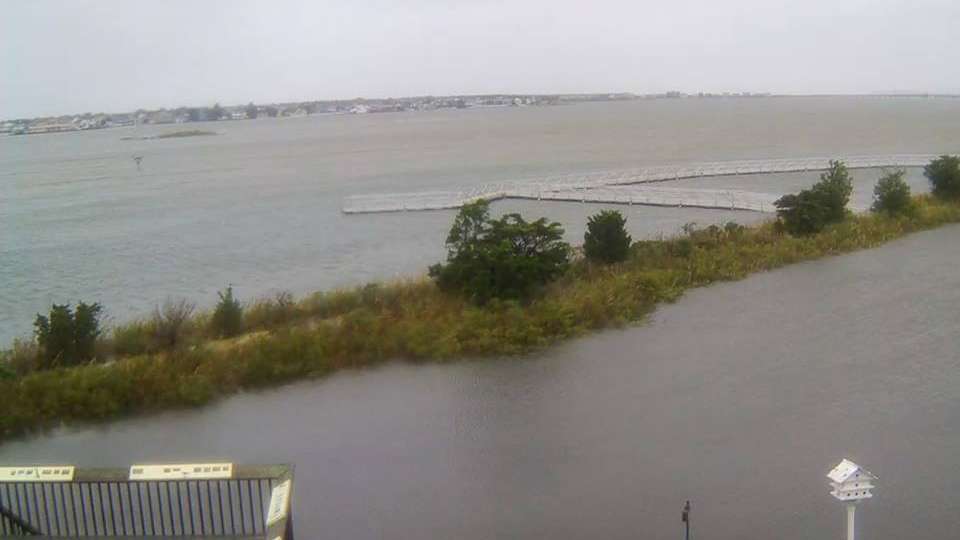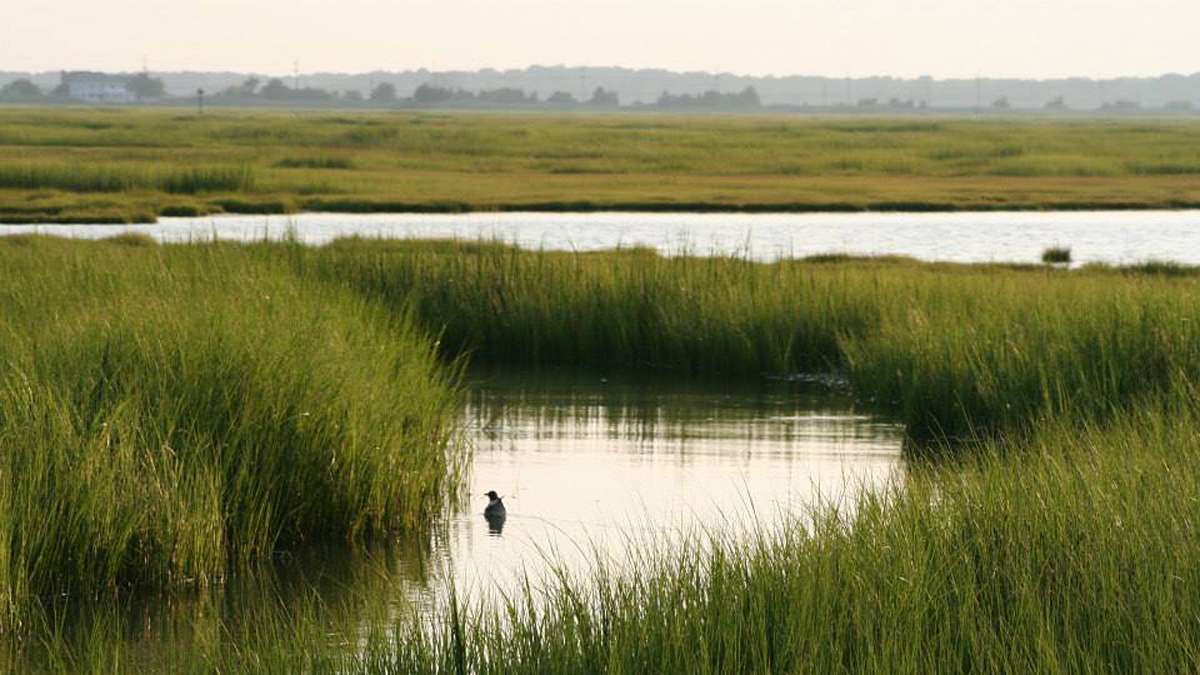Coastal wetlands can act like ‘shag carpet’ during a hurricane
The 2016 hurricane season could produce up to 12 named storms, including two major hurricanes, according to the latest forecast from Colorado State University. The Weather Channel’s independent forecast is calling for a slightly above normal hurricane season with up to three major hurricanes.
This news — coupled with the sight of beach replenishment projects — reminds Jersey Shore residents that we’re entering that time of year when severe flooding is a real possibility.
When it comes to protecting shore towns, the state widens beaches, builds up ocean-front dunes and even builds sea walls. But after many recent storms, including Superstorm Sandy in October 2012, the public is beginning to understand that coastal wetlands can also play an important role in minimizing storm damage.
Wetland areas – broadly defined as the transitional spaces between aquatic and terrestrial environments – impede flooding in two ways.The freshwater type (like the kind you might find within Stone Harbor’s Bird Sanctuary, along a riverbank, at a cranberry bog in the Pinelands, or within the Cape May County Zoo) serve as a sponge, absorbing a million gallons of floodwater per acre before that floodwater can absorb your garage. To a lesser level, coastal wetlands do this, too, but they also work to weaken wave action.
“Think of every storm surge as a bag of marbles,” said Lenore Tedesco, PhD, executive director of The Wetlands Institute in Stone Harbor. “If you spill them on the floor, they’ll go further on hardwood than on shag carpeting, right? Because of their vegetation, the marshes act like shag carpeting, dampening the energy of a wave before it reaches land.”
Which begs the question: if our wetlands provide such great defense against flooding, why hasn’t New Jersey tried building any from scratch? Some experts contend it’s pompous and foolish to attempt creating a delicate ecosystem where the variables (oxygen level, elevation, consistency of mud) leave little room for error. Others say it’s worth a shot.
“They’ve been doing this down south forever,” said Stewart Farrell, PhD, Director of Stockton University’s Coastal Research Center. “I’m talking about Louisiana, or Poplar Island in Chesapeake Bay. They take an area the size of 20 football fields, build a dike around it and fill it with dredge material. The issue isn’t that it’s impossible. The issue is that habitat regulators in this state have very different agendas. A fisheries person fights for open water, a birding person likes uplands. Try to build a salt marsh and you’ll meet all kinds of viewpoints from within the agencies themselves, like the DEP, the Department of Fish and Wildlife, NOAA, the Army Corps of Engineers, and the Tidelands Resource Council. There is no consensus yet. It’s a balancing act.”
Case in point: Farrell has been advocating for the last year and a half to turn part of Shelter Island on the bay side of Ventnor City from an open-water environment into a salt marsh that would, among other benefits, protect against flooding and erosion. The excavation site, which was used to create a sewage treatment plant in the 1930s, is now a 27-foot hole in the bay floor. The water here is so oxygen poor, Farrell’s team can find no signs of life typically existing in an open-water environment, like worms or crabs. This makes it a perfect place to start building up a wetland, but because something could potentially “wander in and set up camp someday,” he said, “the project is unlikely to happen.”
But as overwhelming as all these regulatory checks and balances can be, ecologists say, they slow the machinations of conservation processes so that wetland restoration work can be done right. “We need to ensure the measures we take are done systematically, and that they’re successful,” said Martha Maxwell-Doyle, Project Coordinator for the Barnegat Bay Partnership, which works to protect and enhance Jersey ecosystems. “Otherwise, if a project fails, we risk not being able to do anything else, probably for another generation.”And if the effects of climate change are any indication, we don’t have that time to waste.
“Our coastal wetlands are not able to keep pace with rising sea levels, meaning they are starting to drown,” said Maxwell-Doyle. “Typically, when wetlands can’t keep pace, they slowly retreat back onto land. But the houses and roads of developed areas, like Route 9 or the Parkway, block their way. So what can we do? We can look for ways to help wetlands artificially keep pace.”
So far in New Jersey, two large-scale public projects – the first of their kind here — are doing just that. One is currently underway in Fortescue in Cumberland County. The other — recently conducted in partnership between the Army Corp of Engineers, the DEP and environmental partners — targeted the marshes of Ring Island (in Middle Township, near Stone Harbor’s Wetlands Institute) and Avalon.
Usually, when a channel is dredged in order to make it deeper or wider for boats, the resulting sediment is taken to a CDF, or Confined Disposal Facility, where its potential benefit to the environment is lost forever. But for projects like these, that sediment is used to bolster drowning marshes. In Avalon, this happened through Thin Layer Dispersal. Via hydraulic dredge (aka, an underwater vacuum) a slurry of sediment and water was removed from the Intracoastal Waterway, pumped through a long pipe, and carefully strewn across approximately 40 acres of vulnerable marsh. While state workers as well as non-governmental organizations will continue monitoring the results, initial reports indicate success.
The challenges are big. First, there’s expense. In Avalon, dredging alone cost $1.7 million, while placement, containment, documentation and monitoring costs are still being calculated. Then there’s the level of difficulty. The process for reusing dredge material is a lot more delicate than the process for transporting it to a holding facility. If too few inches are dispersed over a marsh, it won’t be protected. But if too many inches are added, this marsh could end up sinking even further below sea level under the weight, rendering it useless against flooding.
“You can’t just put a dredge in the middle of a marsh and say ‘Have at it,'” said Sam Reynolds, Acting Chief for the Army Corps’ Regulatory Branch. “But dredging contractors are used to, well, having at it. So the issue becomes: how do you effectively manage these projects?”
As the kinks get worked out of an evolving regulatory infrastructure post-Sandy, one thing remains certain – there’s been a tidal shift in the way we think about wetlands. Or, as Farrell puts it, “there’s way more going on than weeds and water.”
“Some days I can’t help but feel like we’re just not moving fast enough,” adds Maxwell-Doyle. “We will lose some of these areas to climate change. On the other hand, it’s heartening to see that we’re finally recognizing how significant wetlands are. They’re not just a place to run your personal watercraft at 90 miles per hour… they’re important for protecting human life.”
WHYY is your source for fact-based, in-depth journalism and information. As a nonprofit organization, we rely on financial support from readers like you. Please give today.
















